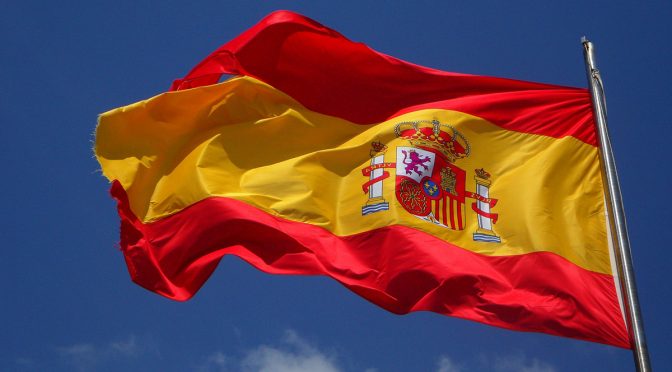Spain is a leader in wind power generation and is the country that installed the most onshore wind turbines throughout 2019 in the EU.
– Wind power has contributed 20.8% of the electricity consumed in 2019 (in 2018 it was 19%), it has avoided 28 M TON CO2, and the import of 10.7 Mtoe of fossil fuels.
– Spain is the EU country that installed the most onshore wind farm plants in 2019, 15% of the total in Europe. Spain occupies the 1st position in the European ranking of power installation / year.
– Spain maintains the 5th position in the world ranking of installed wind energy and 2nd position in Europe. 3rd position in exports.
POWER AND GENERATION
In Spain, in 2019, wind power increased by 2,243 MW, bringing the total installed wind power to 25,704 MW. This new power belongs mainly to projects resulting from the first and second auctions of 2017, but also to merchant plants.
More than 1 GW of the new power (49.1% of the total) corresponds to parks in Aragon. The rest of the installed megawatts, about 1,141 MW, are distributed between 461 MW in Castilla y León, 416 MW in Galicia, 124 MW in Andalusia, 85 MW in Navarra, 39 MW in Extremadura and 16 MW in the Canary Islands. Extremadura, in 2019, has entered its wind farm club with its first wind farm.
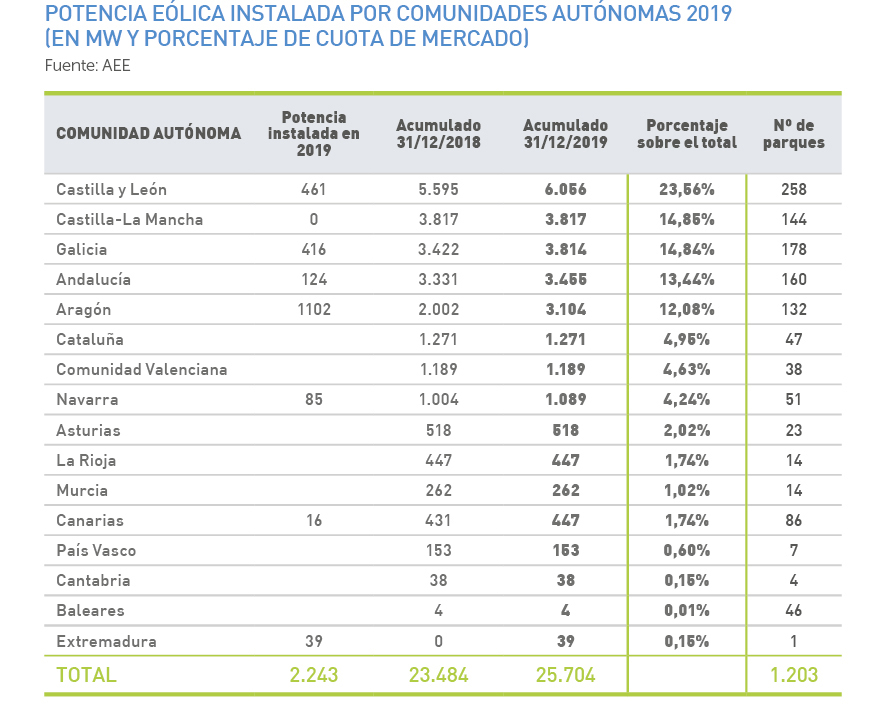
The autonomous community with the highest installed power continues to be Castilla y León, with coverage of electricity demand of 80%. They are followed by Castilla La Mancha with 67.6%, La Rioja with 64% and Navarra with 46%. At the tail are Madrid, Ceuta, Melilla and the Balearic Islands.
THE REDUCING EFFECT OF WIND ENERGY ON THE INVOICE
In 2019, wind power generation has been a benefit for Spanish consumers. The reducing effect of wind energy in the Spanish electricity market in 2019 was € 6 / MWh.
The most benefited from the reducing effect of wind power have been industrial consumers. For an average consumer who has the AT1 Rate and a consumption of 1,500 MWh per year, the savings throughout 2019 has been € 3,115. In other words, if the existing 25,704 MW of wind power were not in operation, electricity would have cost € 3,115 more per year.
In total, wind power generated a net saving (after deducting the incentives) to electricity consumers of 72 million euros.
WIND AND THE INTEGRATED NATIONAL ENERGY AND CLIMATE PLAN (PNIEC)
The National Integrated Energy and Climate Plan (PNIEC) 2021-2030 defines the objectives of reducing greenhouse gas emissions, penetration of renewable energy and energy efficiency. Regarding wind energy, the specific objective for 2030 is to reach 50 GW of installed power (with a volume of 2,300 MW to be installed annually during the decade) and to contribute 34% of total generation (wind currently contributes 20, 8%). In addition, it adds a repowering estimate of approximately 20 GW of wind.
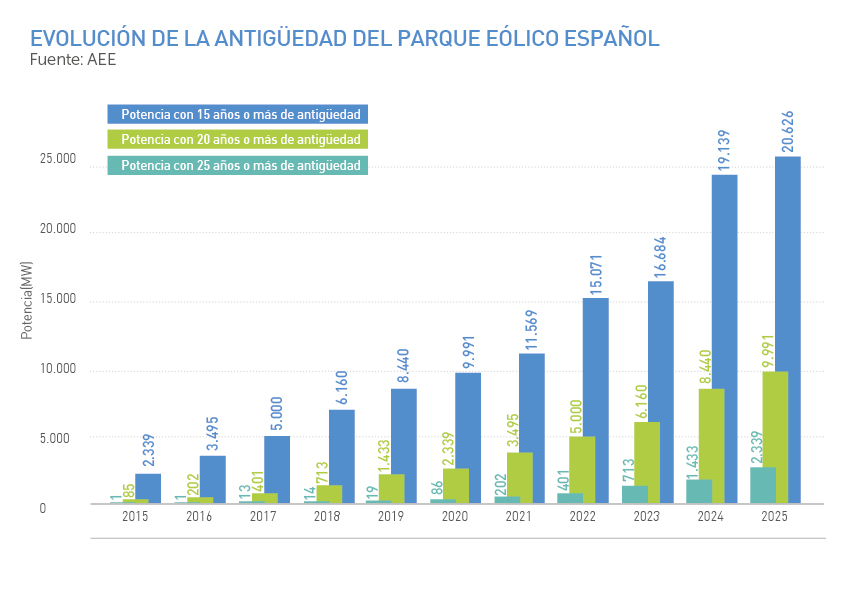
Regarding repowering, in the PNIEC, relevance is given to the renovation of most of the wind facilities in the 2030 horizon and it is established that specific auctions may be organized for facilities to be repowered. Currently, the Spanish wind farm has around 10,000 MW that are over 15 years old, while 2,300 MW of them are over 20 years old.
EVOLUTION OF WIND ENERGY IN THE WORLD AND THE POSITION OF SPAIN
The installed wind power in the world has exceeded 651 GW. During 2019, the global wind power has increased by 60.4 GW. China, USA, United Kingdom, India and Spain have been the countries that have installed the most power in the year and continue to be leaders worldwide.
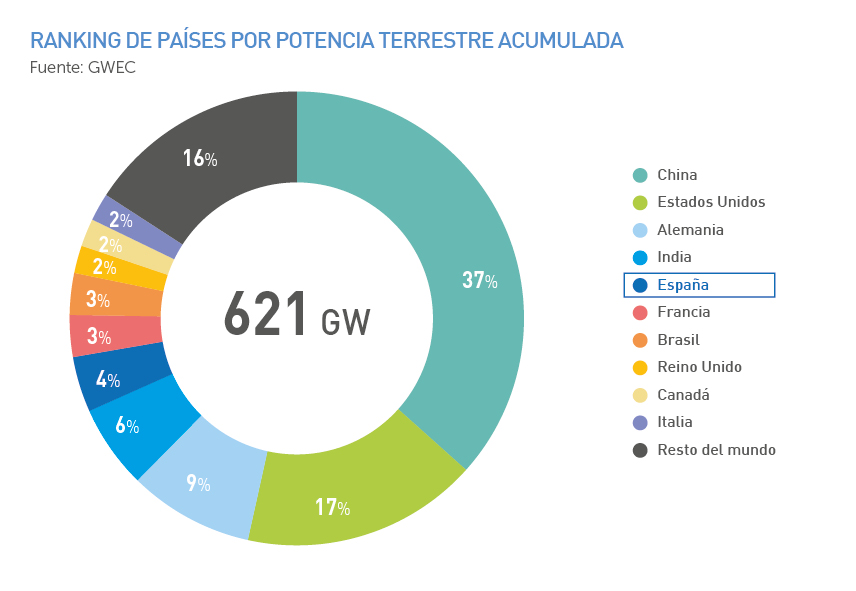
China, in first position in the world ranking, has added 26.1 GW in 2019, and has a wind capacity of 236 GW, 35% of the world’s wind power. The United States has experienced another consecutive year with strong growth in wind energy with the installation of 9.1 GW, exceeding the 100 GW wind installed in the country (105 GW).
In Europe, in 2019, the new power has been led by the United Kingdom, Spain and Germany (new power 15.4 GW in 2019). Of those 15.4 GW installed in Europe in 2019, 3.6 GW were from offshore wind.
In total, the European Union already has 205 wind GW, power that can cover the demand of 74 million households in the EU. In addition, the emission of 271 million tons of CO2 into the atmosphere and the import of fossil fuels worth more than 16,000 million euros have been avoided.
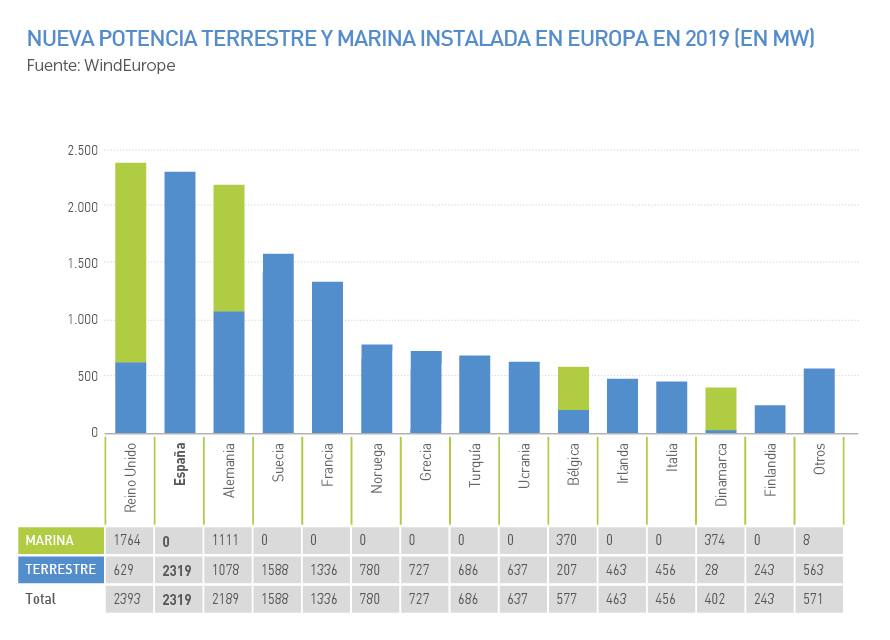
THE GREAT PRIORITIES IN R&D OF WIND ENERGY
Wind energy R&D priorities can be grouped into five main themes:
1. Reduction of energy cost (LCOE).
2. Maintenance of the planned production in different wind conditions.
3. Contribution to the reliability of the network, participating in the different electricity markets.
4. Fundamentally floating offshore wind.
5. Integrated / mixed electricity generation systems
The wind energy sector invests in R&D every year to improve its production and efficiency. In addition to the 5 lines described as main axes, priorities in innovation can be detailed such as:
– The improvement of the knowledge of the behavior of the wind and the flows in the surroundings of the wind farms, and the reduction of uncertainties to reduce the uncertainties of evaluation of the production and sustain the cost of generation foreseen throughout the life of the park.
– The increase in size of the blades is constant to increase production and reduce the cost of generation.
– Transmission systems that support them without increasing the weight or cost of the machines.
– Digitization and its applications in the design of the wind turbine, in the certification procedures, in the diagnosis of the plants, in the operational improvement of the machines and in maintenance.
– Towers and foundations. The challenges are modularity, weight reduction and ease of assembly. The towers and foundations represent more than 30% of the total cost of the wind turbine.
SPAIN, SIXTH POSITION IN THE RANKING OF WIND ENERGY PATENTS IN THE WORLD
Since 2006, 810 wind patents have been filed in Spain and we continue to maintain the 6th position worldwide, proof of the technological and innovative capacity of the wind farm sector.
